How to choose a wall-hung toilet: which is better and why + review of manufacturers
The undeniable advantages of hanging plumbing tempt many owners of houses and apartments to change their usual options to innovative types.However, the new models are somewhat frightening with the unknown. Agree, before choosing a wall-hung toilet, it is advisable to learn more about this type of equipment.
We offer you to familiarize yourself with information that will give you the opportunity to navigate a wide range of models from different manufacturers. We describe in detail the types of installations required for the installation of hanging plumbing, and the types of bowls. For those who love comfort, we list hygiene options.
To complete the perception of a large amount of information, we have attached photo selections, graphic illustrations, and video recommendations to the text.
The content of the article:
- Wall-hung toilet - a compact version of plumbing fixtures
- Pros and cons of plumbing products
- Types of toilet mounting systems
- Reinforcement: invisible but important components
- Choosing a toilet bowl
- Important parts: cover and button
- Additional features and functionality
- Review of the best manufacturers
- Conclusions and useful video on the topic
Wall-hung toilet - a compact version of plumbing fixtures
Wall-hung toilets appeared on the specialized market in the 1980s. During this period, the style of minimalism gained rapid popularity, into which such plumbing products fit perfectly.
In contrast to the rather impressive traditional devices, hanging options give the impression of being miniature and light; moreover, when installing them, the entire sewage system is removed behind a false wall.
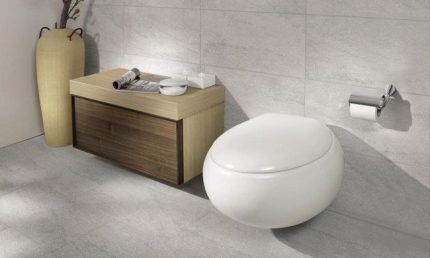
The innovation immediately gained popularity among users, but there were also those who remained faithful to traditional models. Let's look at why this happened.
Pros and cons of plumbing products
This type of plumbing has many strengths:
- The products look very stylish and fit well into various bathroom designs.
- Pipes and other communication systems are hidden behind the false panel, so they do not spoil the appearance of the room.
- The absence of a foot and free space under the bowl makes cleaning easier, helping to maintain hygiene in the bathroom or toilet.
- Wall-hung types of toilets take up less space than conventional plumbing fixtures. They also visually enlarge the room.
- Many models of this type allow you to save water because they have a half-drain mechanism.
- Plumbing fixtures typically produce less noise because the installation often includes an additional layer of sound insulation.
Wall-hung toilets are strong, reliable and durable.
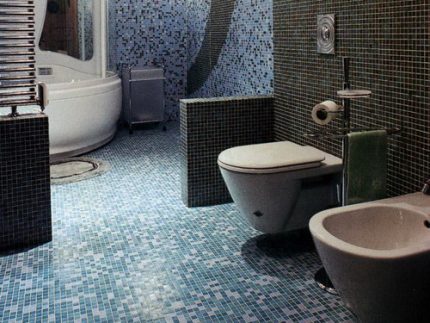
Although this technique has many advantages, we must not forget about some disadvantages. Disadvantages include:
- Relatively expensive. Prices for wall-hung toilets vary quite a bit, but all other things being equal, they are still much more than similar floor-standing devices.
- Difficult to install. Installation of such plumbing requires experience, dexterity, and special knowledge, so it is better to be undertaken by skilled craftsmen.
- Difficult access to communications. The false panel covering the installation prevents access to pipes and fittings, which is necessary in some situations. In such cases, you will have to completely remove the finishing material, dismantle the partition, and then seal the damaged area.
When planning to purchase plumbing fixtures, you need to carefully study the pros and cons of a regular and wall-hung toilet, and then choose a model of the type that is suitable for its design. When choosing, you should also take into account a number of product characteristics.
Types of toilet mounting systems
Installation - a structure on which the bowl is fixed, as well as all plumbing fittings (tank, pipes, flush control). There are two types of such devices: block and frame.
Modification #1 - block installation. A simple and inexpensive design of small size is mounted in a niche made in the wall.
All the fittings are attached to the block structure and the toilet is mounted, after which the hole is closed using waterproof plasterboard, and then additionally decorated with finishing materials.
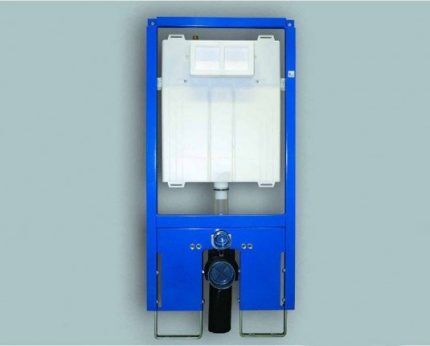
The main disadvantage of the block system is that it cannot be installed in partitions and walls made of thin material (wood, foam blocks, gypsum plasterboard). Such structures are compatible only with permanent ceilings, which significantly narrows the scope of their application.
Modification #2 - frame installation. A more complex and expensive option is a steel frame (most often with an anti-corrosion coating), onto which the necessary components of the plumbing fixture are hung.
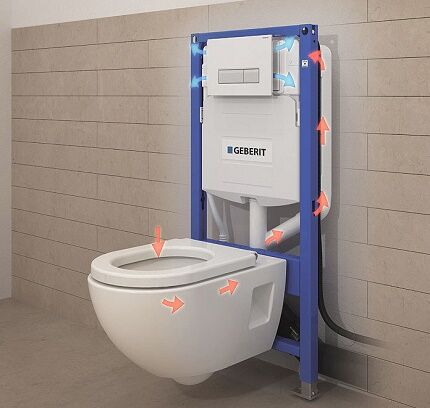
The frame structure has large dimensions (depth 15-30, width 50-60, height up to 140 cm). This type of installation can be installed almost anywhere in the room. It is important to choose the appropriate model and mounting option:
- If the installation is mounted near a plasterboard or foam block partition, the floor option looks preferable (the frame is installed on legs).
- For load-bearing floors, wall installation is recommended: the structure is mounted on a vertical covering, to which the entire load is transferred.
- There is also a combined option: the structure is fixed on both vertical and horizontal surfaces.
The choice of design is also influenced by the location of the toilet. If you plan to place it under a window, it is advisable to purchase a shortened frame.
It is worth highlighting the following options for plumbing systems:
- Corner systems that are fixed at the junction of walls at a certain angle.
- Products equipped with a traverse attached to the floor. This design feature allows the toilet to be used as a bidet.
All models of wall-hung sanitary ware can be compared to consoles, allowing for even distribution of body weight. Thanks to a well-thought-out design, the devices, despite their apparent fragility, can withstand weights of up to 400-500 kilograms.
Reinforcement: invisible but important components
Fittings are attached to the installation: tank, pipes and other parts.
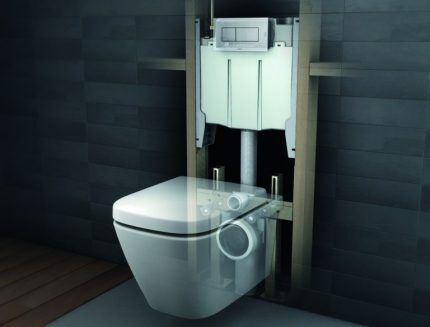
All components must be made of especially durable polymers or metal with an anti-corrosion coating. The button can be connected to the sewer fittings using a pneumatic device, a lever or a cable, with preference given to the first two mechanical methods.
Choosing a toilet bowl
The design of a wall-hung toilet and the features of its operation largely depend on the material and functionality of the bowl.
Material: from faience to Bohemian glass
For the manufacture of such devices, various types of materials are used, among which the following can be especially noted.
Porcelain. Plumbing products made from this noble material have a perfectly smooth surface, which prevents the accumulation of dirt and greatly facilitates cleaning of plumbing fixtures.
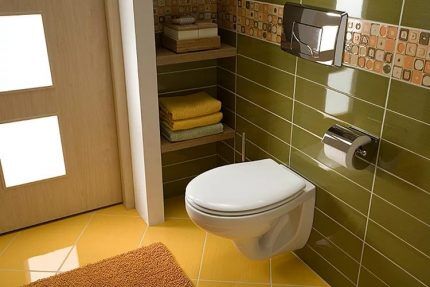
Faience. Although at first glance this budget material resembles porcelain, it has an uneven, rough structure that contributes to the formation of plaque in the bowl. A more comfortable option is earthenware toilets, additionally coated with glaze. Such products look great, are comfortable to use, and easy to care for.
Stainless steel. Such plumbing fixtures have a distinctive appearance, are durable and require minimal maintenance. However, their design is more suitable for public bathrooms than for a cozy powder room.
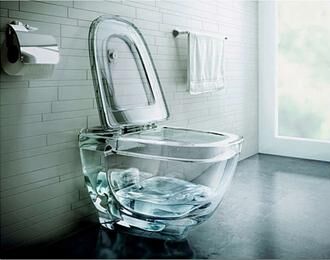
Glass. Although glass toilets look unusual and impressive, they are not often found in bathrooms.The reason for this is not only the high price, but also the need for regular, complex cleaning.
Plastic. Polymer structures are easy to care for, but they are not reliable enough, as they are easily subject to mechanical damage. They are most suitable for dachas, where they are used only in the warm season.
Polymer concrete (fake diamond). Products made from this material are distinguished by their original design, reliability, and durability. Their disadvantages are high price and instability to acidic environments.
Despite the variety of materials, the most popular are ceramic products: thin porcelain and denser earthenware.
Sizes: “kids” and “giants”
Size is an important factor that plays a big role when choosing a toilet. Depending on the dimensions, all suspended plumbing fixtures can be divided into three categories:
- Compact devices no longer than 54 cm. Such models are primarily intended for installation in miniature bathrooms and bathrooms. This group also includes ergonomic corner options that allow optimal use of every centimeter of space.
- Plumbing fixtures of medium size (54-60 centimeters). These are the standard models that the vast majority of buyers choose.
- Toilets with increased dimensions (60-70 cm). Such devices are convenient to use for people with disabilities; they are also chosen to decorate spacious toilets.
When choosing the size of hanging structures, it is important to take into account personal preferences and the size of the room where it will be installed. In a spacious space, a compact model will “get lost,” and in a small room, even a standard device will “eat up” too much space.
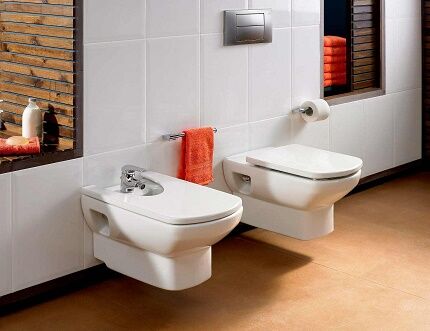
Shape: there is no limit to your imagination
In the assortment of manufacturing companies you can find models of wall-hung toilets of various designs.
It is believed that round or oval-shaped toilets are most practical:
- they do not have sharp corners, which reduces the possibility of injury by accidentally bumping into a plumbing product;
- Caring for the surface of such devices is quite simple. It is much easier to clean a smooth oval surface with a brush or other device than a complex curved bowl.
In addition to such standard options, there are rectangular, teardrop-shaped, square designs and devices with complex design shapes.
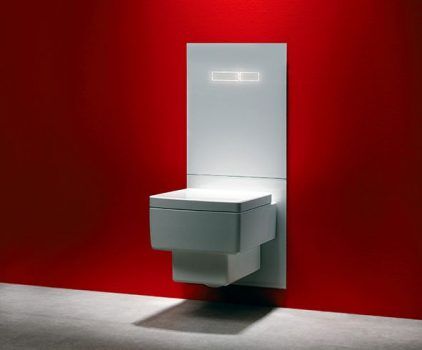
When choosing a model, you should proceed from the style of the bathroom. For the Art Deco style, streamlined or teardrop-shaped shapes are suitable, while traditional designs are best chosen for a room in a classic style. The size of the room is of a certain importance (in small rooms, toilets with complex shapes look ridiculous) and personal preferences.
Internal structure of the bowl
The internal space of the toilet bowl can have a variety of shapes (visor, dish-shaped, funnel-shaped). The latter is considered the most hygienic, but it produces a lot of splashes. To avoid this, you can use the anti-splash system.A good option in terms of comfort and quality of cleaning are visor-type containers, which have a special shelf that protects from water drops.
It is worth especially noting the following design features of the bowl structure:
- A bowl with a gentle slope to the drain is considered especially comfortable to use;
- It is undesirable for the water surface to occupy the space directly below, as this may cause splashes.
Careful attention to such parameters will help to avoid discomfort when using a wall-hung toilet.
Color: not only white
The standard option is white wall-hung toilets. Recently, manufacturers have significantly expanded the color palette, offering customers products of different shades, sometimes additionally decorated with drawings.

Particularly worth noting are colored sanitary ware, which enjoy increased public attention due to their stylish appearance and ease of maintenance.
Toilet flush device
This function can be organized in different ways:
- Straight (horizontal) flushing is created by a stream of water, which is supplied from behind and, having washed the front part of the bowl, goes into the drain. The disadvantage of such structures is splashing.
- Reverse (circular) flushing is caused by many small holes that are located around the perimeter of the upper part of the bowl. Due to the fact that these holes are located obliquely, water flows out of them in a spiral, twisting into a powerful funnel. This not only improves the quality of flushing, but also ensures reasonable fluid consumption.
Dual flush systems are also aimed at saving water. They have two buttons, one of which includes a full tank reset, and the second – a half-drain, which can also be interrupted instantly.
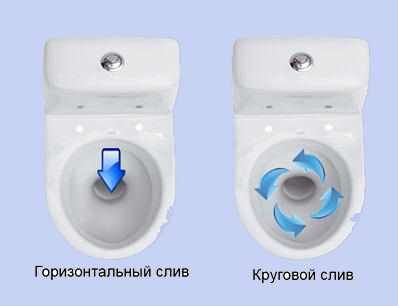
New is a rimless wall-hung toilet with a directional flush system. This option is considered the most hygienic.
Particularly technologically advanced toilets may have touch controls that activate the device immediately after lifting the lid. Draining also occurs automatically as soon as a person leaves the coverage area of the infrared sensor.
In terms of price/quality ratio, experts call plumbing devices with a circular flush the best option.
Important parts: cover and button
When choosing a toilet model, it is advisable to pay attention to the lid, which can be:
- traditional;
- having an automatic device that can lift the lid in a split second;
- equipped with a microlift system that ensures smooth lowering.
The latter function is useful in that it prevents mechanical damage to the lid when closing the toilet abruptly. Additionally, an antibacterial coating can be applied to the lid and seat to prevent the development of microorganisms.
A small but important detail is the flush button. It can be single or double, if different tank drain systems are provided (full and half, allowing you to save water).
Since the button is the only part of the fitting that is visible, manufacturers attach great importance to the design of this part. You can find buttons that have a wide range of colors: from traditional white to richly bright, from neutral to pearlescent metallic.
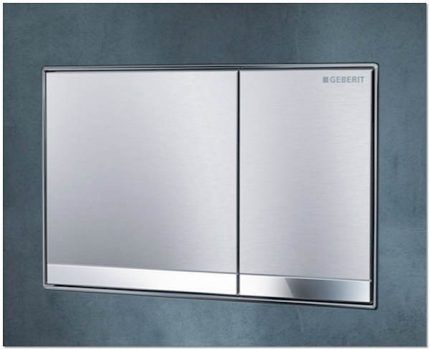
The large size of the buttons is due to the fact that an inspection window is hidden under them, allowing you to monitor and adjust the functioning of the shut-off valve and other fittings.
Additional features and functionality
Wall-hung toilets can be additionally equipped with a variety of devices, for example, an anti-splash system. This design shifts the center of the drain hole, due to which splashes of water are extinguished when draining. The bowl can be coated with a dirt-repellent glaze, which prevents the formation of plaque and rust inside the container.
Some models of wall-hung toilets are additionally equipped with options such as:
- aeration;
- built-in bidet;
- blowing;
- drying;
- remote flush control using a remote control;
- heating of the toilet seat with possible temperature adjustment.
Moreover, the latest Japanese devices can even analyze the remains of the body’s vital functions, providing the owner with comprehensive information about the state of his health.
However, it should be noted that additional functions directly affect the cost of the wall-hung toilet model.
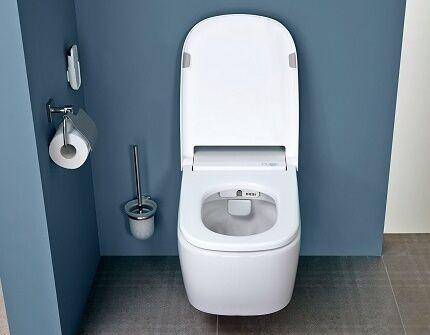
Review of the best manufacturers
Among the companies specializing in the production of suspended plumbing, the following can be mentioned.
Geberit. The Swiss company Geberit produces exclusively luxury models: electronic toilets with a large number of additional functions (sensor flush, built-in bidet, water heater). The prices for such products correspond to the quality: in the company’s catalog you can rarely find plumbing fixtures costing less than 100 thousand rubles.
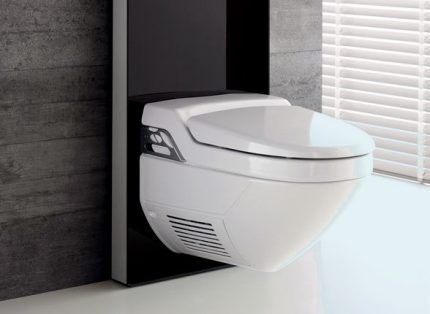
Spanish company Roca. The collections of this brand present a variety of models with a predominance of high-tech style. Toilets with round or square bowls can have lids with a microlift or regular ones.
The size range of the brand also looks impressive:
- length 35.55-86 cm;
- height 40-76 cm;
- width 50-70 cm.
The cost of models varies significantly: you can choose both budget options costing 4-5 thousand rubles, as well as more expensive models of 20 thousand and above, equipped with additional functions.
Villeroy & Boch. Wall-hung toilets from a reputable German company are distinguished by high quality and a diverse range of models. Among the presented range you can find both miniature models in a minimalist style, ideal for small bathrooms, and solid devices in a classic style.
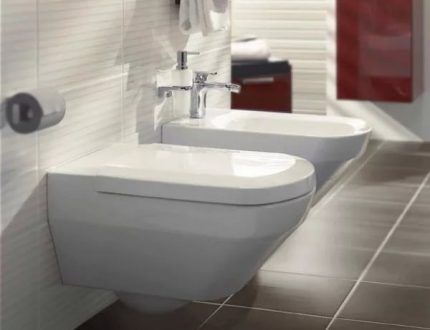
The price range for Villeroy & Boch toilets is quite wide: from 6 thousand to 50 thousand or more rubles.
Jacob Delafon. French Jacob Delafon sanitary ware has a proven, memorable design. Toilets have a wide variety of shapes: square, trapezoidal, rectangular. The material is usually porcelain, the seats are mostly equipped with a microlift. The size range is quite large, including models of different sizes - from small to medium and large. Prices for products are moderately high: from 15 to 30 thousand rubles.
Vitra. The Turkish brand Vitra belongs to the economy class, but produces quite high-quality plumbing fixtures. Many models of this company have additional useful functions (anti-splash system, lids with microlift).
Customers will be pleased with the variety of sizes, allowing them to choose products of different dimensions. The plumbing fixtures of this company are characterized by a streamlined design: even square and rectangular toilets have smoothed, rounded corners. Prices are affordable: on average from 5 to 10 thousand rubles, although there are also more expensive models.
Сersanit. The Polish company Cersanit produces economy-class plumbing fixtures.The line is dominated by wall-hung toilets of a semicircular shape, made of faience (duroplast is used for seats), without any additional functions. Products are manufactured only in standard sizes: it is useless to look for non-standard dimensions from this manufacturer.

A regular Cersanit toilet without fasteners can be bought for 3-4 thousand rubles.
Laufen. The Austrian company Laufen produces a wide variety of toilet models: classic, teardrop-shaped, in the shape of an inverted pyramid or a duck. Their size range is also very wide: there are sanitary ware of different sizes.
Although the devices are mostly made of earthenware, they have a number of additional functions (for example, antibacterial coating, micro-lift lid). The cost of models is very diverse: from 5 to 25 thousand rubles.
In addition to those listed above, other manufacturers also produce excellent hanging plumbing fixtures, for example, the well-known German company Ideal Standard Duravit, the budget Czech company Jika or the Swedish Ifo.
Conclusions and useful video on the topic
Below we present you a video that gives professional advice on choosing wall-hung toilets:
Wall-hung toilets are a high-quality and comfortable option for modern plumbing fixtures. A correctly selected model will serve you for many years, and its stylish design will positively transform your bathroom or toilet room.
We are waiting for your stories about how you chose, purchased and installed a wall-hung toilet. Please write comments in the block below. Here you can ask questions and share interesting facts.




I learned about such hanging plumbing quite recently, when global renovations were in full swing. It came to the bathroom, and, naturally, the question of buying a toilet arose. We began to carefully study the pendant ones, but decided to take the classic one. I don’t argue that this model is probably somewhat more convenient, more practical, takes up less space, but it’s also not cheap now. We decided to wait out this “boom” and wait for the price to drop :) In the meantime, we purchased, so to speak, a traditional toilet and are quite satisfied.
Wall-hung toilets are no longer something unusual. Among my acquaintances there are no longer people who do not understand the advantages and convenience of such sanitary equipment. I like the ease of cleaning and washing the floors in the toilet area; there is no tank, which also requires constant cleaning. At first there was distrust of the small volume of the built-in tank, but it turned out that flushing is more efficient due to the greater height.
Dubious advantages. You don’t clean a public toilet with 10 toilets, and you don’t wash the toilet every day, so this would be decisive when choosing.
For the first time we decided to install a wall-hung toilet. Installed am pm it has a nice looking design. The water fills normally, the drain washes everything away the first or second time, depending on the amount of paper.
Hello. Could you suggest a model of toilets for men, where the design of the toilet allows you not to rest your manhood against the intravenous wall? For some reason, no matter how much I looked at Obi and Leroy, all the compacts were there. The Russian Santek is an exception, but I don’t want to take them because they look primitively cheap.